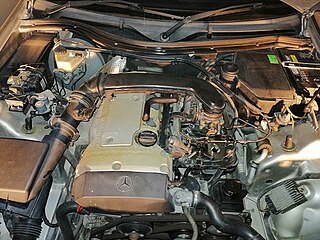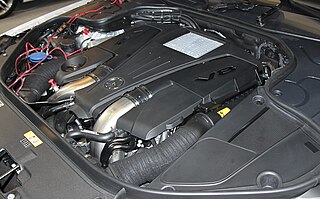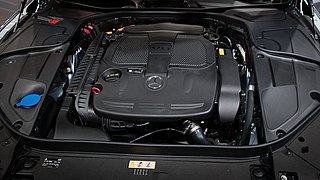Mercedes-AMG GmbH, commonly known as AMG, is the high-performance subsidiary of Mercedes-Benz AG. AMG independently hires engineers and contracts with manufacturers to customize Mercedes-Benz AMG vehicles. The company has its headquarters in Affalterbach, Baden-Württemberg, Germany.

The Toyota AZ engine family is a straight-4 piston engine series. The AZ series uses an aluminium engine block with cast iron cylinder liners and aluminium DOHC cylinder head. The engine series features many advanced technologies including slant-squish combustion chambers, offset cylinder and crank centers, and the VVT-i continuously variable intake valve timing system. The aluminium engine measures 626 mm (24.6 in) long, 608 mm (23.9 in) wide, and 681 mm (26.8 in) tall.

The Mercedes-Benz M120 engine is a naturally aspirated high-performance automobile piston V12 engine family used in the 1990s and 2000s in Mercedes' flagship models. The engine was a response to BMW's M70 V12 engine, introduced in 1987. While the 5-litre BMW unit developed 300 metric horsepower (220 kW), Mercedes-Benz upped the ante considerably by creating a 6-litre, 300-kilowatt (408 PS) engine.

The Mercedes-Benz M275 engine is a twin-turbocharged and intercooled, all-aluminium, 60° V12 automobile piston engine family used in the 2000s to the 2010s. It is loosely based on the M137 naturally aspirated V12 sold between 1998 and 2002, and retains its SOHC, 3 valves per cylinder, twin-spark ignition layout, but differs with the addition of structural reinforcements to the engine block for improved rigidity which in turn yields greater reliability. The M275 V12 Bi-Turbo engine was modified with the addition of larger turbochargers. Several variations of the M275 V12 Bi-turbo engine have powered many top-of-the-range Mercedes-Benz and Maybach models since 2003.

The Mercedes-Benz M112 engine is a gasoline-fueled, 4-stroke, spark-ignition, internal-combustion automobile piston V6 engine family used in the 2000s. Introduced in 1996, it was the first gasoline V6 engine ever built by Mercedes. A short time later the related M113 V8 was introduced.

The Mercedes-Benz M113 engine is a gasoline-fueled, spark-ignition internal-combustion V8 automobile engine family used in the 2000s. It is based on the similar M112 V6 introduced in 1997, then later phased out in 2007 for the M156 AMG engine and the M273 engine.

The C209/A209 Mercedes-Benz CLK-Class is the second generation of the Mercedes-Benz CLK-Class range of grand tourers, produced between 2001 and 2009. There were two body styles available: a 2-door coupé (C209) and a 2-door convertible (A209). The latter being assembled at the Karmann plant in Osnabrück. It was also the last complete car made by Karmann before closing the facility.

The Mercedes-Benz R129 SL is a roadster which was produced by Mercedes-Benz from 1988 until 2001. The R129 replaced the R107 in 1989 and was in its turn replaced by the R230 SL-Class in 2002 for the 2003 model year.

The M110 engine family is a DOHC crossflow cylinder head design with 2 valves per cylinder straight-6 automobile engine made by Mercedes-Benz in the 1970s and 1980s.

The Mercedes-Benz M119 is a V8 automobile petrol engine produced from 1989 through 1999. It was available in 4.2 L; 5.0 L; and 6.0 L displacements. It was a double overhead cam design with 4 valves per cylinder and variable valve timing on the intake side. It was replaced by the 3-valve M113 starting in 1997.

The R230 generation of the Mercedes-Benz SL-Class was introduced at the 2001 Frankfurt Motor Show and 2001 Bologna Motor Show, replacing the R129. The R230 underwent revisions in 2006 and 2008, and was superseded by the new SL-Class R231 in 2011.

The M156 is the first automobile V8 engine designed autonomously by Mercedes-Benz subsidiary Mercedes-AMG, as previous AMG engines have always been based on original Mercedes engines. The engine was designed to be a naturally aspirated racing unit, and is also used in a number of high-performance AMG-badged Mercedes-Benz models. The engine was designed by Bernd Ramler, famed by the design of the Porsche Carrera GT's 5.7-liter V-10 engine.

The Mitsubishi 4A9 engine is the newest family range of all-alloy inline four-cylinder engines from Mitsubishi Motors, introduced in the 2004 version of their Mitsubishi Colt supermini, and built by DaimlerChrysler-owned MDC Power in Germany.

The Mercedes-Benz M272 engine is an automobile piston V6 engine family used in the 2000s (decade). Introduced in 2004, it is based on the M112 V6 introduced in 1998.

The M111 engine family is a straight-4 automobile engine from Mercedes-Benz, produced from 1992 to 2003. Debuted in the 1992 Mercedes-Benz E-Class (W124), this engine family is relatively oversquare and uses 4 valves per cylinder. All engines in the family use a cast iron engine block and aluminum alloy cylinder head.

The Mercedes-Benz M278 is a family of direct injected, Bi-turbocharged, V8 gasoline automotive piston engines.

The Mercedes-Benz M276 engine is a direct injected, gasoline automotive piston V6 engine.

The M176/M177/M178 is a petrol V8 engine range designed by Mercedes-AMG, replacing the M278 and M157 engines, and is based on the M133 engine.

The Mercedes-Benz OM629 is a 4.0 litres (3,996 cc) diesel-fuelled, 4-stroke, compression-ignition internal combustion 75° 32-valve V8 engine used in the 2000s.

The Volkswagen-Audi V8 engine family is a series of mechanically similar, gasoline-powered and diesel-powered, V-8, internal combustion piston engines, developed and produced by the Volkswagen Group, in partnership with Audi, since 1988. They have been used in various Volkswagen Group models, and by numerous Volkswagen-owned companies. The first spark-ignition gasoline V-8 engine configuration was used in the 1988 Audi V8 model; and the first compression-ignition diesel V8 engine configuration was used in the 1999 Audi A8 3.3 TDI Quattro. The V8 gasoline and diesel engines have been used in most Audi, Volkswagen, Porsche, Bentley, and Lamborghini models ever since. The larger-displacement diesel V8 engine configuration has also been used in various Scania commercial vehicles; such as in trucks, buses, and marine (boat) applications.



















